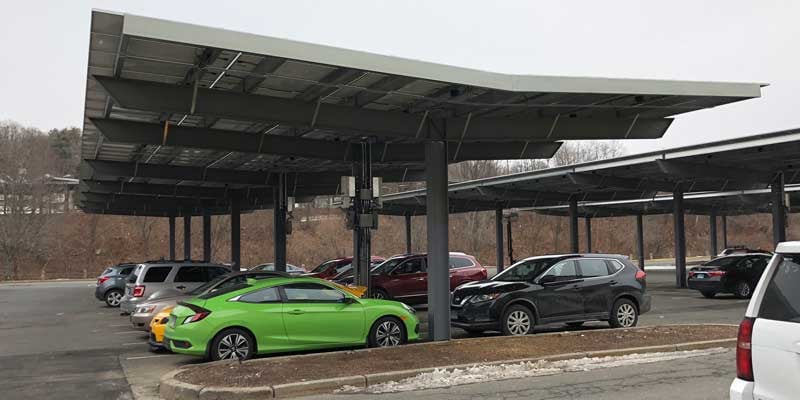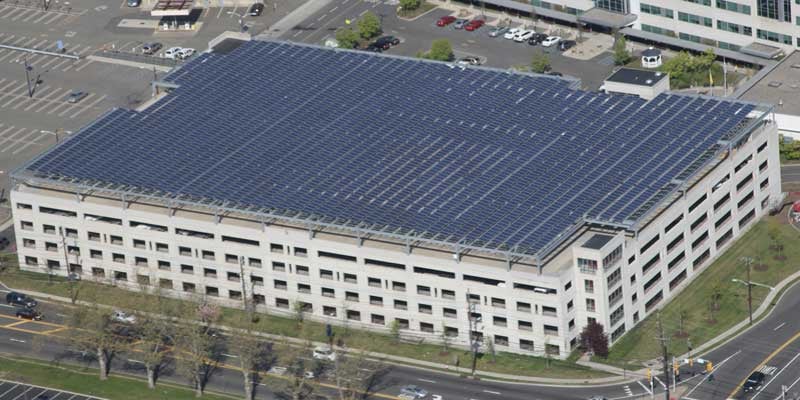Carports and canopies are the most expensive type of racking or PV module support structure. Therefore, its critical to optimize equipment selection and value engineer these projects.
If you have a hard time getting the costs to pencil out on your commercial solar carport, perhaps some of the concepts in this 2-part series can help.
Part 1: Carports on Ground Level versus On a Building - This article below
Part 2: Inverter Selection and Location (click here)
Is the solar carport at ground level or on a building?
From a value engineering standpoint, one of the most consequential considerations is whether the authority having jurisdiction (AHJ) is going to treat the solar carport as a building or part of a building. Its usually obvious if it’s a ground level carport, but less so when its on a parking garage. We will discuss both types below:
GROUND LEVEL CARPORTS.
If a solar carport is not on a building, code requirements are less stringent. This is most likely the case for carports resembling elevated ground mounts, such as those installed over a paved ground level parking lot.
 Below are several factors Pure Power will consider when value engineering a ground level solar carport:
Below are several factors Pure Power will consider when value engineering a ground level solar carport:
Rapid shutdown is NOT required.
When carports are at ground level and not on a building, the Rapid Shutdown requirements of NEC Section 690.12 does not apply. The extra expense of module-level power electronics is not required.
Maximum system voltage is increased to 1500 Volts DC (Vdc).
NEC Section 690.7 limits the maximum DC voltage to 600 Vdc on residential buildings and 1,000 Vdc on commercial and industrial buildings. However ground level carports can operate up to 1,500 Vdc since it’s not on a building.
1,500 Vdc inverters provide some advantages. All else being equal, increasing DC voltage will increase string length, allow for smaller gauge conductors, reduce voltage drop, and improve operating and financial efficiency. HOWEVER, while you may be tempted to go with the highest DC voltage possible, it is not always the best choice for every site.
Inverter AC voltage considerations.
480Vac / 1000Vdc inverters: Most PV carports are behind-the-meter installations at facilities with a 480 Volts AC (Vac) utility service. A 1000 Vdc inverter usually has a 480 Vac output, allowing for a direct interconnection without a step-up transformer.
600Vac /1,500Vdc inverters: 1,500 Vdc inverters usually have an 600Vac output. 600V is not a typical utility service voltage, and will require a transformer at the point of interconnection (POI) to step down the inverter output to the utility’s 480 Vac or 208 Vac service voltage. Transformers are expensive long lead items that will increase project cost and introduce conversion losses (similar to additional voltage drop), so we generally try to avoid transformers where not necessary.
Large facilities with medium-voltage (MV) interconnections may be an ideal candidate for 600Vac/1500Vdc inverters since the solar project will inherently require an transformer to step up to the utility service’s higher voltage. Since the cost of a transformer is needed either way, you can get the benefits of the 600Vac/1500Vdc inverters without adding additional transformer costs.
|
Attention Engineers! Check out our open positions here. |
CARPORTS ON A BUILDING.
Carports themselves are not a building, but they could be considered “on a building” when on the top level of a parking garage. The code requirements change when the carport is on a building, and therefore the system must be value engineered in a different way.
 Rapid shutdown could be required.
Rapid shutdown could be required.
Rapid shutdown is an electrical code requirement intended to reduce the risk of shock to emergency responders on a roof. As described in NEC Section 690.12:
“PV system circuits installed on or in buildings shall include a rapid shutdown function to reduce shock hazard for emergency responders.”
Emergency responders should not be walking on top of a solar carport or trying to vent roof as they would with a rooftop, so designing a garage-top carport with rapid shutdown doesn’t add the additional level of safety for emergency responders as it does for a system mounted directly on a roof. However, since the code language above isn’t clear for parking garages, some AHJs may consider a garage-top carport to be “on or in a building” and require module level power electronics. This interpretation will increase system cost, both due to the additional materials and an increase in installation time. So it may make sense to consult the AHJ to get their interpretation on NEC 690.12 and whether Rapid Shutdown inside the array boundary is required for garage-top carports. In either case, we still want to control the voltage outside the array boundary, but there are several cost effective ways to do that.
DC Voltage limited to 1000 Vdc.
As discussed previously, when PV circuits are on a commercial building the maximum DC voltage is 1,000 Vdc. All inverters designed for use in commercial behind-the-meter applications in North America will accommodate a 1,000-volt DC operating voltage limit. However, you can’t use 1500V DC inverters as with ground level carports.
Inverter AC voltage considerations.
The obvious advantage of using 1,000 Vdc inverters for PV carport systems on a building is the ease of interconnection to a 480V service. 3-phase 480 Vac is the most common output voltage in commercial and industrial applications. The options are more limited for 3-phase 208 Vac or 240 Vac interconnections, it may still be possible to accommodate these interconnection voltages without a costly transformer.
CARPORTS ON A BUILDING AND/OR GROUND LEVEL:
Hire an Architect or Civil Engineer
Successfully designing and building a carport involves more than just the electrical and structural engineers. An architect or civil engineer (CE) is highly recommended (and usually required) to ensure the site approvals and permits go smoothly. Sometimes a developer will try to push a small carport project through permitting without the involvement of a CE or architect, but that usually comes back to bite them. Each township has their own unique requirements for fire setbacks from buildings, property line setbacks, easements, minimum structure heights & turn radius (for emergency vehicles), maximum structure size (IBC), sprinkler requirements, ADA coverage requirements, etc. Many clients that are pros at rooftop systems often don't budget time or resources to the architectural aspects of the project, and as a result run into costly delays.
More in Part 2 of 2
To fully value engineer a system, there are a few more factors to consider, as discussed in part 2 of this article.
For more tips on optimizing commercial- or utility-scale PV power systems, contact Pure Power Engineering to learn more about our value-engineered design and construction drawing services.
.png)
